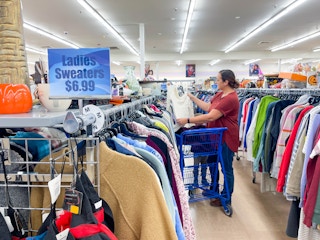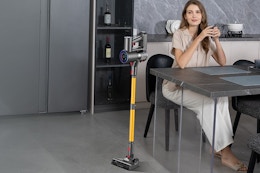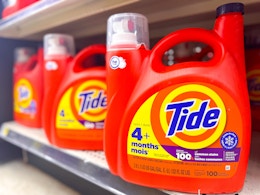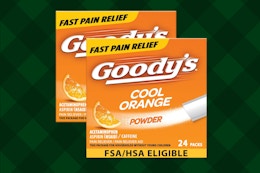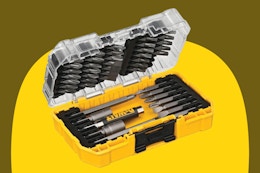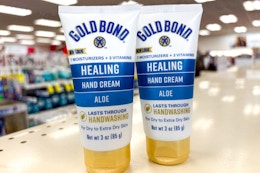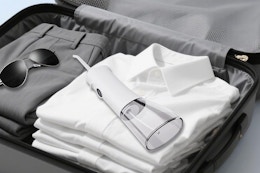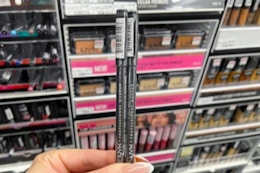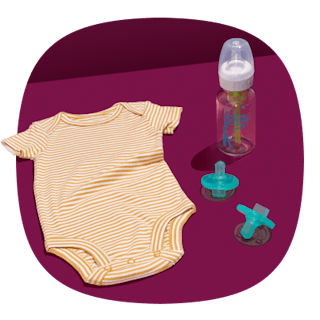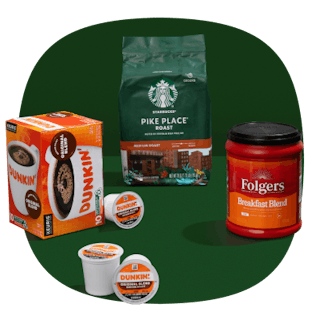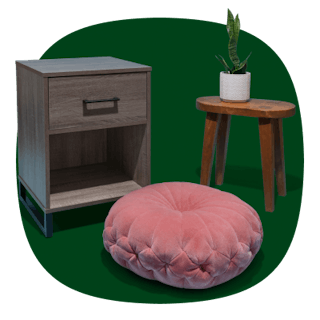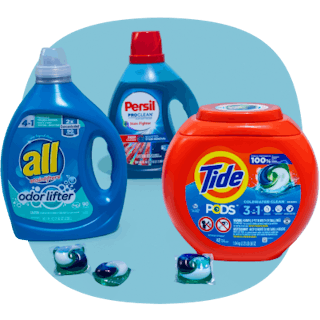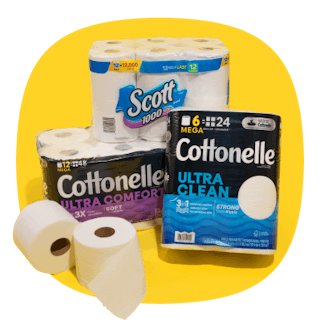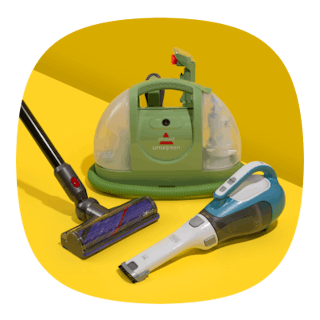Thrifting is quickly becoming the way for Gen Zers and their parents alike to push back against the waste of fast fashion. What better gift could you give to the planet than to breathe new life into clothing and goods that would otherwise overcrowd a landfill?
However, starting out thrift shopping can be intimidating and overwhelming. Good news: It doesn’t have to be! If you know how to shop at them (including how to save at Goodwill ) it can actually feel breezy. All it takes are great instincts, a willingness to play by the rules, and some solid intel, which I’m going to give you right here and now.
Since we can’t always get stuff for free (though we really love free stuff ), thrifting is the second best option. Forget whatever you’ve heard about thrift stores in the past and study up on these insider tips — you and your wallet won’t regret it.
1. Do your thrifting in small towns instead of big cities — trust me!

Seems counterintuitive when it comes to thrifting because we think the best high-quality and brands are in thrift stores in the poshy areas of town, but I promise it’ll pay off. Small towns frequently don’t get enough donations to stock their store, so inventory is shipped in from large cities with a surplus. For example, the Goodwill in Boise, Idaho doesn’t always have the best finds, but the Goodwill in The Dalles, Oregon is a gold mine. I’ve even found discounted Coach bags !
The objective isn’t just to find the best stuff, but get to it before anyone else does. That’s why stopping to thrift in small towns while you’re passing through is a win/win. Awesome stuff sent from bigger cities, plus less competition.
2. Use Label Resource to determine if you’ve found a piece of vintage clothing.
Sometimes it’s hard to know if you’ve got a vintage piece of clothing or not. Use your smartphone to check the Label Resource at the Vintage Fashion Guild when you find one you can’t identify. You’ll get a little bit of info about the item, and then pictures of authentic labels to compare the item you found and determine if it’s vintage or not.
3. Heads up: vintage clothing runs four to six sizes smaller than modern clothing.
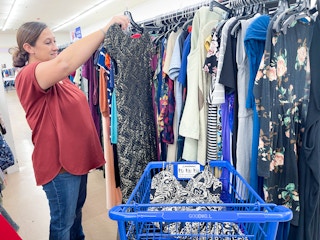
Be sure to size up if you’re looking at a vintage item. And I mean “vintage” in the truest sense. Not “vintage” like 1980. This means it pays to look in the sizes that are larger than the one you usually wear, too.
4. What are some cheap thrift stores near me?
Great question. I recommend you check out some of the more common thrifting stores websites to see what you’ve got in your area. Also you can just search the web for “thrift stores near me” to see a more localized list of options. Or check our list of the best thrift stores in every state .
Here are store locators for some of the bigger thrift stores:
-
Is there a Goodwill near me?
-
Is there a Savers near me?
-
Is there a Value Village near me?
-
Is there a Salvation Army near me?
-
Is there a Buffalo Exchange near me?
-
Is there a Plato’s Closet near me?
5. Sleuth out what each thrift store in your area specializes in.
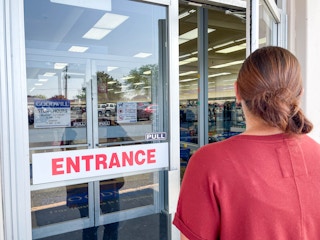
Once you know which cheap thrift stores are near you, there’s still one more step before you thrift your little heart out. Do some reconnaissance by driving to each one and scoping out the merch. One store may be the best for furniture, and another for designer jeans. Knowing which to shop for the items you’re looking for will save you time and energy. For example: In my area, it’s easier to find designer jeans at Savers/Value Village than the other stores. Goodwill is the place to find good furniture, and Salvation Army is best for inexpensive kids’ books and toys. It may be different for you, depending on your town, and inventory.
Of course, if you’re just planning to show up and buy whatever hot deals the Universe puts before you, this is less important.
6. The best things to buy are furniture and kids’ clothing.
Let’s face it, as a parent you know how fast kids grow out of clothes and shoes. And if they don’t outgrow their stuff, it’s because everything gets destroyed before it can be outgrown. Thrift stores let you keep your kid well dressed on a budget. Do you love The Children’s Place, Baby Gap, and Gymboree? Thrift stores are overflowing with cute pieces from standalone children’s clothing stores at around $1. You can often get just as lucky with furniture!
7. The worst things to buy are swimsuits and underwear.
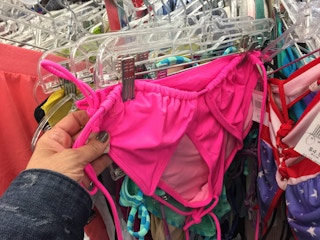
Because…well, I really don’t think I need to explain this one. Ha! Ha!
8. Shop for whatever clothes are off-season.
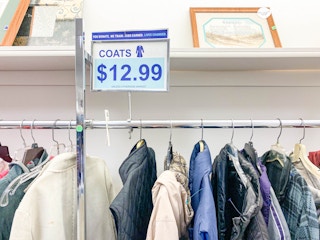
This is true for thrift stores just like it’s true for retail stores. The very best deals are for clothes that aren’t currently in high demand. If you keep a list and shop smart, you can score things like a Wilson’s Leather bomber jacket for only $5, because everyone else is buying sundresses. Find out where you can sell your clothes .
9. Look for items to repurpose.
Part of learning how to thrift is exercising your creativity. Sometimes you won’t find exactly what you’re looking for, but you might find something that you can repurpose. For example, I was hunting for an end table for my son’s room and couldn’t find one at my price point. But I found a snare drum that was broken on the bottom and turned it into a cool end table for only $6!
Another trick is to examine the frames of photos and art. It’s easier than you think to find a frame and mat that might be valued in the hundreds marked down to single digits. All because the print inside is dated! Just think of the possibilities…
10. Find out when your fave thrift store restocks and shop on that day.
Each store is different, so you’re gonna have to ask. This information is gold and will save you from stopping in when inventory is low. Plus, you’ll get first dibs on new product as it gets put on the floor. I’ll give you a head start: It’s probably not Saturday. And you’ll want to avoid Saturday for more reasons than that. It’s the day everyone is off and thinking about shopping! You want the holy grail of the first day of fresh inventory, and less competition in the store.
11. Shop the first day after your store marks items down.
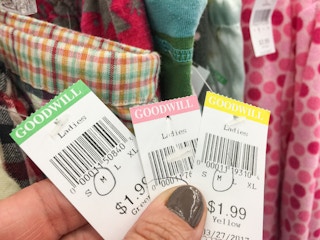
Most stores have a color of tag that goes on sale each week on the same day. For example, our local Goodwill store has a color tag that goes on sale for only $1 every Monday. And every week on Wednesday, they discount a specific color tag by 50%. In general, Savers marks down their tags on Monday, and Goodwill marks down their tags on Sunday. But definitely double check with your local store to be sure.
12. Be strong in the face of nostalgia.
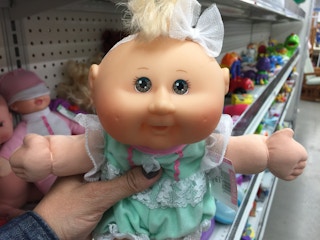
Thrifting can be the equivalent of walking into a pop culture graveyard. You’ll find all kinds of things you remember from being a kid — count on it. The smell of a Cabbage Patch doll, the feel of a Beanie Baby in your hands.
But stick to your goals! If you don’t have a use for these things (and you couldn’t make money reselling them), walk on by.
13. Don’t want to go to the store? Shop online thrift stores.
Thrifting doesn’t have to be an in-person activity. Online thrift stores, like ThredUp, are well organized with finds at great prices. Yes, you’ll pay more for an online thrift store purchase, but if you’re squeamish about going to the store and digging, this is a great option.
TIP: Wait to shop ThredUp until they at least offer free shipping codes. If you’re new or haven’t shopped in a while, they should also give you a major discount code of up to 50% off.
14. Give yourself a 45-minute time limit per store.

It’s easy to get pulled into a several-hour-long trip when you’re shopping thrift stores, but don’t do it! You’ll get that fuzzy, numb brain feeling because your body and mind are trying to tell you they’re done thrifting even if you don’t want to be. Pace yourself and plan to visit your favorite stores a couple times a week for a quick pop in, bounce out. Think: more frequency, less total time spent in store. This is the way to avoid burnout and giving up.
15. Dress to match what you’re shopping for (and don’t plan on fitting rooms).
Looking for a prom or wedding dress? Wear heels so you know how the dress will fit! Shopping for furniture? Wear tennis shoes so you can lug that thing out of the store by yourself. (You know you’ll have to!) And always, always wear layers. Not all thrift stores have dressing rooms, and it’s much easier to try on that sweater if you can easily remove a sweatshirt or cardigan.
Related: How to Save at Goodwill
16. Don’t bother with clearance.
Another tip that seems counter-intuitive, I know. But it can take three weeks for something at a thrift store to go on clearance, and by then, it’ll probably be gone. The name of the thrifting game is inventory + low prices. (And taking into account your energy level.) Why bother combing through nasty thrift clearance and wasting all that energy that could be spent deciding between pieces you love.
If you must shop clearance, go to a retail store like Kohl’s or Target. Clearance shopping is best at these types of stores.
17. Learn markers of quality so you can easily spot valuable pieces.
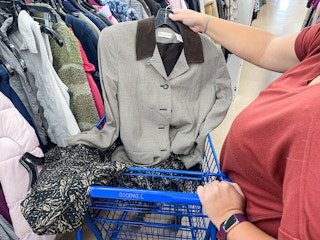
Thrifting is good for not only saving money and helping keep items out of landfills, it’s also good for finding truly great pieces. In order to do this, you have to know what to look for.
Here are some basics:
-
Hardwood furniture is better quality and will last longer than veneer. Hardwood will have the same grain all the way through, and furniture with a veneer will be made of plywood on the inside and feel less porous.
-
Natural materials are more expensive, regardless if it’s furniture or clothing, so when you see natural materials, you’re looking at a higher quality piece.
-
Lining in a blazer means it’s a higher quality item of clothing. The best blazers are also a wool blend.
-
A woven, not printed, tag in a piece of clothing means it’s a more expensive brand.
-
Expensive, 100%-leather shoes will have a mark on the sole and the words “vero curo.” Shoes that are leather but have a rubber sole will be marked “leather upper.”
18. Haggle over the price if an item is broken or damaged.
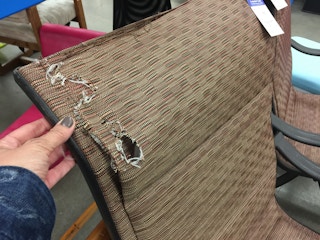
Thrift stores frequently price like items at a single price regardless of quality. If you spot something that you want, but it’s lightly damaged, don’t be afraid to ask for deeper discounts.
19. Keep track of your thrifting wish list on a Pinterest board.
Make sure you keep track of the items you’re hunting for by creating a Pinterest board just for thrifting. Take your phone with you (as if you wouldn’t), and give yourself a quick refresher before you start to shop.
20. Always test electronics before you buy.
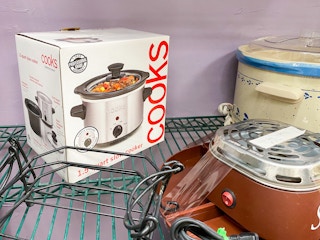
This is Thrifting 101: Keep a pocket full of different-sized batteries on hand to test toys and gadgets. Most thrift stores also have outlets available for testing items with cords. Make good use of them!
21. Check that all parts of your game, puzzle, toy, etc. are there before buying.
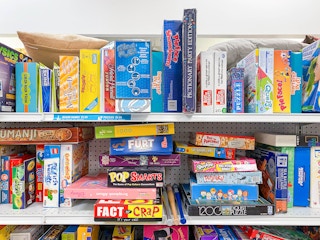
Nothing worse than getting home with a gently used Monopoly game, only to find the Boardwalk card is totally MIA. This can be tedious, but what’s the point of buying if you can’t play the game or finish the puzzle?
22. Make friends with the employees, and they may hook you up.
This is even better advice at the thrift store than it is for traditional retail stores. At my favorite Goodwill, the cashier and the manager know me well enough that they’ll set aside pieces they know I’m looking for. That’s what you want!
23. Aim to save 80% – 95% on new retail prices.
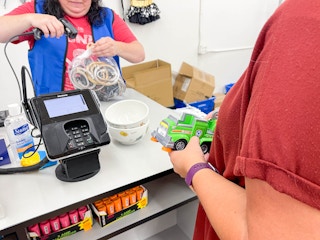
Since most of what you find at thrift stores isn’t new, it follows that you should never be paying more than 20% of what the original retail price of the item was when new. Aim for more than that — I’m not exaggerating when I say you can get as much as 95% – 99% off original retail prices.
24. Keep your eyes peeled for seasonal coupons.
Coupons will be different for every store and for every region. But definitely watch for them because often stores will release coupons several times a year during peak shopping times (think Christmas). For example: In the past, Savers has offered a free $5 off any $5 or more purchase when you buy a $25 gift card for Mother’s Day.
25. Don’t overlook the grandma-ish stuff.

Becoming a seasoned thrift shopper means developing an eagle eye for the good stuff. Sure, that porcelain bunny/etched vase/bamboo nightstand could have come from your Nana’s house, but it could actually be pretty valuable. Familiarize yourself with old-school, expensive brands like Henredon, Wedgewood, and Lenox so you can spot these and regift or — even better — resell them.
26. Assume some stains are permanent.
You may be able to test appliances at thrift stores, but you can’t exactly spot treat and wash clothes. For example, stains under the pits are usually there to stay, as are Sharpie, bleach, and dye marks. If the deal is good enough, it may be worth bringing the item home to try and clean up the mystery stain, but don’t get your hopes up.
27. Don’t (always) let broken or damaged items scare you.
Back in the day, furniture with a nasty scratch, a watermark, or missing hardware was written off. Now thanks to blogs, Pinterest, and TikTok, we know that even the pieces that seem the most hopeless have potential — and usually, it’s easier than you’d think to revive them .
28. Get a 20% off coupon when you make a donation to Goodwill.
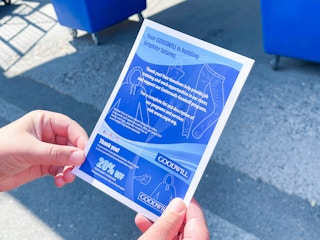
Some Goodwills offers a 20% off coupon with any donation. If this is true for yours, keep a bag of old clothes in your trunk and donate them one bag at a time to stock up on coupons.
29. Thrifting at GW (Goodwill Boutique) will get you designer stuff, but for a slightly higher price.
GW is a standalone store in North and South Carolina that sells used designer clothes, shoes, accessories, home decor and more. This is the more curated version of your standard Goodwill, featuring name-brand items. The prices are a touch higher, but if you’re short on time or patience and have bougie taste, you’ll still save a ton of money compared to retail prices.
30. Returns are iffy — you usually only get 7 days and can’t get cash back.
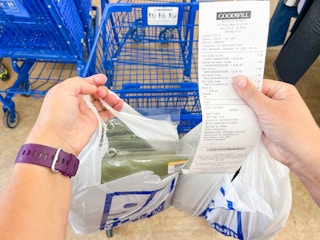
Make sure you really love that find because you usually won’t be able to return it! If you shop often and don’t mind store credit, this is a good option for clothes that don’t fit, though.
31. Employee discounts exist, but they’re different for each store chain.
You’d think an additional discount on already-discounted goods was something that only happened in dreams. But no, this can be your reality if you find thrifting is your thing and you’re looking for a job. Depending on your store.
Here’s the scoop:
-
Goodwill gives 25% off, and it can be stacked with sales, but you’re not allowed to shop in your own store.
-
Value Village/Savers gives 50% off of all clothing or apparel, and all other items 30% off.
-
Salvation Army: No employee discount.
32. Stack your military/senior discount with sale days or coupons.
Many thrift stores offer military or senior discounts. For example, Goodwill offers 10% off to seniors over 60 every Tuesday. Don’t have a military discount or senior discount? Take Grandma shopping with you!
33. Sign up for email alerts and discounts from Savers/Value Village.
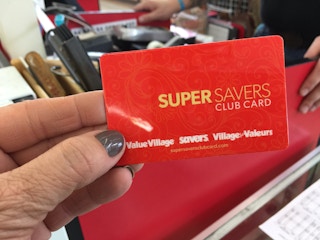
Savers is the best for offering a loyalty program. Sign up for their Super Savers club and get exclusive email notifications for sales, early access to deals, and more.
34. Be on the lookout for brand new items.
A lot of Targets have a standing arrangement with Goodwill and other salvage stores to donate any unsold clearance goods when they don’t sell. This means you can find totally new clothes, seasonal items, and toys for a fraction of the cost. Look for original Target or other retailer’s tags.
35. Church consignment shops can be a gold mine.
If you have bougie taste, you’re going to be pleasantly surprised by church consignment shops’ inventory of china, furniture, and home decor. They have Goodwill-esque prices too, so don’t count them out if you don’t. Also, the great thing about consignment shops is the longer the stuff sits there, the cheaper it becomes.
36. If you’re looking for something specific, try resale sites.
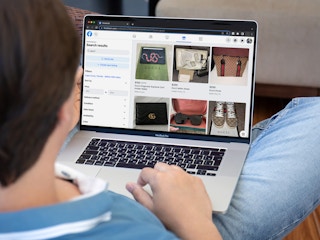
Resale sites are surprisingly totally underutilized. Which one you should use depends on what you’re looking for. The best auction site is eBay, and it definitely has the largest and most diverse amount of items. Facebook Marketplace and Poshmark are my favorites because I find them the easiest to shop — the former is ideal for local purchases like furniture, while the latter is great for clothes and small home pieces. Mercari is similar to Poshmark, but I don’t use it as much because I don’t find it as easily searchable.
37. Skip thrifting at the Goodwill Outlet (unless you’re an experienced thrifter).
If this isn’t your first rodeo, and you’re only reading this to hone your already awesome thrifting skills, skip to the next tip. You already know the Goodwill Outlet can be a gold mine.
But if you’re new to thrifting, it’s not the place to start. It’s way too easy to get overwhelmed by the environment and underwhelmed by the stock. If you do go, bring bags for storage and gloves because … well, you don’t know where that stuff has been.
38. Buy discounted Goodwill gift cards on Raise.com to save up to 5%.
Want to stack even more discounts on top of buying at thrift stores? Buy a Goodwill gift card on Raise.com and save another 5% on your shopping trip. This isn’t a guarantee, as the gift card inventory fluctuates, so check in with Raise frequently in order to buy Goodwill gift cards when they show up.
39. Prices aren’t the same across different stores, so no price matching.
If you’re a seasoned savvy shopper, you’re probably relying heavily on price matching and price adjusting at stores like Target, Kohl’s and more. As you should be! But thrift stores set their own prices. Not only that, but they often don’t have identical items as other thrift stores (or even two Goodwills won’t have the same items). You won’t be able to price match at all, even to another store in the same chain. And thrift stores don’t give you the difference when they put something on sale after you buy it (price adjustments).
Download the KCL app to add and redeem coupons in store

